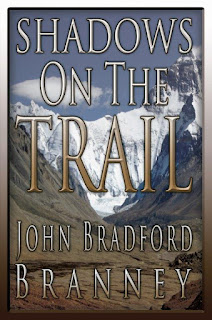 |
| Click to order Shadows on the Trail |
The first tribe I introduced in the book was the Folsom People. I interlaced the language of the Lakota Sioux with English for their personal names, places, and common phrases. For example, the name of our main character, Chayton, means Falcon in the language of the Lakota Sioux.
For the River People, I employed the language of the Cheyenne Indians for personal names, places, and some common phrases. For example, the name of the heroine of the River People, Namid, means Star Dancer in the language of the Cheyenne Indians.
Finally, for the aggressive and hostile Mountain People I employed the language of the Comanche Indians for their personal names and places. For example, the warrior Tosarre's name in Comanche means Dog.
 |
| Click to Order Ghosts of the Heart |
One of the more memorable scenes in Chapter 10 of the first book Shadows on the Trail was when Keya of the Folsom People tribe (designated boy in the dialogue) finds Honiahaka from the River People tribe spying on the Folsom People's camp along the river. In the dialogue below, Keya only speaks the Lakota Sioux tongue while Honiahaka only understands the Cheyenne tongue. What happened with the conversation was a perfect example of a 'failure to communicate'.
Hidden behind scrub oak bushes along the river, Honiahaka watched the camp. It had been two suns since he had nearly drowned in the river. He smelled the roasting meat coming from the camp and his shrinking stomach growled in protest. Since he had eaten the frog legs at the marsh, his diet had consisted of grasshoppers, a small fish, and several more frog legs. He was famished.
Honiahaka now had a much better view of the village. He could now see the people’s faces. SMACK! An object whacked Honiahaka in the back of the head, knocking him flat. Before he could react, someone jumped on his back and shoved his face into the dirt. The attacker then grabbed one of
 |
| Click for Adventure |
"Nitúktetanhan hwo?–Where are you
from?” the boy asked Honiahaka.
Honiahaka did
not understand.
"Táku eníciyapi hwo?–What is your
name?” the boy asked, pushing the knife blade into Honiahaka’s neck.
Honiahaka stared
in bewilderment at the boy.
“Oh ya lay hey?-Who are you looking
for?”
Again, Honiahaka
did not understand this strange language.
"Waniyetu nitóna hwo?–How old are you?”
“Noxa'e!–Wait!” screamed Honiahaka.
"Táku eníciyapi hwo?–What is your
name?” the boy asked again.
Honiahaka had no
idea what the boy was saying, but he started screaming out his own name anyway,
“Honiahaka! Honiahaka!”
“What kind of
name is that?” the boy asked and then punched Honiahaka in the jaw. Before
Honiahaka could recover, the boy was standing over him with a fluted spear
point brushing up against Honiahaka’s chest.
“Inánjinyo!-Stand up!” the boy screamed, motioning
him to stand with his spear. Honiahaka crawled slowly to his feet.
“Walk!” the boy ordered,
pointing his spear in the direction of the camp.
My primary reason for using Native American languages in the Shadows on the Trail Trilogy was to make the dialogue between characters appear more authentic than merely speaking English or even using broken English. I wanted to present the Paleoindian characters as intelligent and insightful without resorting to the stereotype of 'dull witted cavemen who grunt and groan'. Based on skeletal remains and archeaological evidence, we can assume that the Paleoindians were intelligent hunters and gatherers with the same brain capacity as modern day humans.They could plan, create, and solve problems, as well as we can. A Paleoindian would probably not survive very well in our modern world, but I can guarantee that most modern humans could not survive in the Pleistocene filled with predatory animals and no cell phone to dial 911.
Click to Join the Adventure
My primary reason for using Native American languages in the Shadows on the Trail Trilogy was to make the dialogue between characters appear more authentic than merely speaking English or even using broken English. I wanted to present the Paleoindian characters as intelligent and insightful without resorting to the stereotype of 'dull witted cavemen who grunt and groan'. Based on skeletal remains and archeaological evidence, we can assume that the Paleoindians were intelligent hunters and gatherers with the same brain capacity as modern day humans.They could plan, create, and solve problems, as well as we can. A Paleoindian would probably not survive very well in our modern world, but I can guarantee that most modern humans could not survive in the Pleistocene filled with predatory animals and no cell phone to dial 911.
So far, I have received mostly positive reviews for using authentic Native American languages in the Shadows on the Trail Trilogy. Some readers have to told me that the use of these languages brings a higher level of authenticity to the book while other readers have found it a distraction. You be the judge! Read the Shadows on the Trail Trilogy and then give me your opinion!
Click to Join the Adventure







